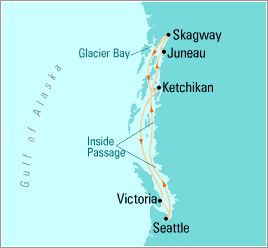
Seattle/Juneau/Skagway/Glacier Bay/Ketchikan/Seattle
June 12 -June 20, 2004
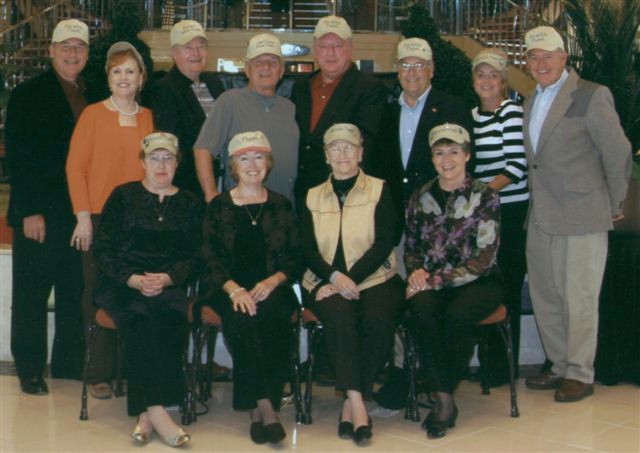
After boarding and settling in we had the mandatory life boat drill before the ship could leave port. We met for dinner together, which was almost the only time until Friday that we all managed to eat together. We were each doing our own thing, which when traveling with a group you have to do. Some of us ended up on the same shore excursions by chance, which was nice.
Though most of us had been to Alaska before, one thing that intrigued us throughout the cruise was how late it stayed light, due to the time of year and being so far north. Our shortest nights were June 16 (Skagway) when sunrise was 3:45 a.m. and Sunset was 10:17 p.m., and Thursday (Glacier Bay) when sunrise was 3:59 a.m. and sunset was 10:01 p.m. This made for mighty short nights and long days, and late evening card playing with daylight. Another thing that surprised us was the weather - it was very warm in Skagway and Ketchikan, to the point that the locals were wearing shorts and sandals and some of us were buying ice cream to stay cool. Well, that's our story, and we're sticking to it...
Sunday, June 13: Left port out of Seattle early evening,
Sunset 9:09 p.m.Monday, June 14: Cruised the Inside Passage,
Sunrise 5:25 a.m., Sunset 10:06 p.m. Cruising a bit of open sea proved a little much, to the discomfort of some of us... but we returned to the calm waters of the Inside Passage and its beauty and enjoyed relaxing and watching the view with the occasional glacier visually flowing down. Carved by glaciers and blanketed with majestic hemlock and spruce, Alaska�s Inside Passage is a region of pristine water, snow capped mountains, deep fjords and forested islands. With its mild, maritime climate, this area is prime habitat for bald eagles, sea lions, porpoise and whales. Much of the southern panhandle is part of the Tongass National Forest, a 16.8 million acre rainforest. Glacier Bay National park has 16 active tidewater glaciers and Misty Fiords National Monument near Ketchikan has 3,000-foot cliffs rising directly from pristine ocean channels. The picturesque coastal communities are rich in history. Russian influence is well preserved in churches and other historical structures. The Gold Rush era comes to life throughout the Inside Passage and offers fascinating opportunities to learn and explore the past. The Native cultures of Tlingit, Haida and Tsimshian Indians dominate this area.Tuesday, June 15: Juneau,
Sunrise 4:07 a.m., Sunset 10:02 p.m. Juneau is on Gastineau Channel at the base of Mt. Roberts. It is the capital and third largest city of Alaska, but still has a small town atmosphere. The Mendenhall river and Mendenhall Lake lie at the foot of Mendenhall Glacier. There is a tramway to take you to the top of Mt. Roberts for tremendous view of the area. We had several hours in port today. Four of the men went fishing but only one was successful. Tom's fishing skills came through and he caught a 19 1/2 pound salmon about ten minutes before the end of the alloted time before having to return to the ship. It was a "real drag" for those who didn't catch anything. The others did various things - hiking and shopping around Juneau. The four of us ladies who went shopping checked out the Red Dog Saloon (to see its antiques and walk on its sawdust floor, of course), and the four fishermen paid the saloon a visit also, to celebrate the salmon catch. After we returned home the salmon arrived in Prescott frozen and packed in ice. We had a salmon bake at the Allens' home in August and had a great evening laughing, reminiscing and watching a CD slide show that Tom the fisherman made for everyone.
Wednesday, June 16: Skagway,
Sunrise 3:46 a.m.,
Sunset 10:17 p.m.
Skagway is a great old town. One of the things Dale and I did was a street car tour around town, including a graveyard with ancient tomb stones and we heard stories of old Skagway. We heard tales of some of the old cowboys and prospectors who had lived in Skagway. In the afternoon six of us rode the White Pass & Yukon Railroad, which is dubbed The Scenic Railway of the World. We could easily see why! It took us on a 20.4 mile (40.8 round trip) four-hour ride to the Canadian Border and back to Skagway.
Thursday, June 17: Glacier Bay,
Friday, June 18: Ketchikan,
Sunrise 4:07 a.m.,
Sunset 9:26 p.m.
Ketchikan's history dates back to 1883 when a man named Snow built a salmon saltery. By the early 1900s a cannery had been set up by businessmen from Portland, Oregon. The town was officially incorporated in 1900 with a population of 800. Originally established as a fishing camp, it today is known as the salmon capital of the world and currently has a population of 14,500.
Saturday, June 19: Victoria, British Columbia, Canada,
Sunrise 5:17 a.m.,
Sunset 9:16 p.m.
Well, we're back to almost normal sunrise and sunset times. Victoria is known as the "City of Gardens".
Sunday, June 20, just before midnight (or oh-dark-thirty on the clock...) Prescott: We all arrived home safe and sound, tired - but not tired of each other - still friends, and ready to travel together again. Now that we've invested soooo much in our
"I'm with Them" hats, we really should use them again sometime.
We'll be spending three and a half weeks in Italy, so watch for another addition to our web site this winter.
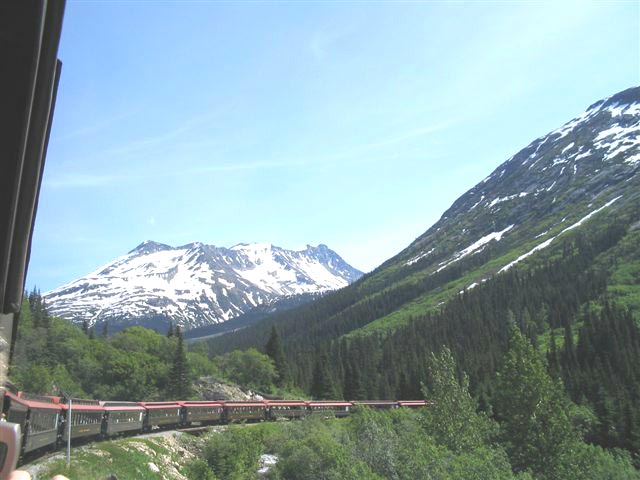 In 1994 the railroad was designated an International Historic Civil Engineering Landmark, an honor shared by only 36 world civil engineering marvels such as the Eiffel Tower, Statue of Liberty and Panama Canal. It is a narrow gauge railroad, as it made building it easier than blasting for a full size track. Designers and builders had to overcome challenges such as granite mountains, steep grades, cliff hanging turns and unimaginable weather conditions. The views are unbelievably gorgeous and unmatched. Skagway is known as the Gateway to the Klondike and lies at the head of the Lynn Canal, gateway to the Golden Interior. It is said the North Wind blows so much that you will never breathe the same air twice. The downtown area has been restored and looks much like it did in the 1890s when it was a gold rush boomtown. Some of "Them" went on the Klondike Gold Dredge tour and panned for gold. Those of us who took the Street Car tour became "honorary card-carrying members of Camp Skagway No. 1 Arctic Brotherhood", promising to "spread the good word about Skagway, Alaska in general, and the Arctic Brotherhood in particular." A cute little play was presented showing how the people lived during the gold rush days.
In 1994 the railroad was designated an International Historic Civil Engineering Landmark, an honor shared by only 36 world civil engineering marvels such as the Eiffel Tower, Statue of Liberty and Panama Canal. It is a narrow gauge railroad, as it made building it easier than blasting for a full size track. Designers and builders had to overcome challenges such as granite mountains, steep grades, cliff hanging turns and unimaginable weather conditions. The views are unbelievably gorgeous and unmatched. Skagway is known as the Gateway to the Klondike and lies at the head of the Lynn Canal, gateway to the Golden Interior. It is said the North Wind blows so much that you will never breathe the same air twice. The downtown area has been restored and looks much like it did in the 1890s when it was a gold rush boomtown. Some of "Them" went on the Klondike Gold Dredge tour and panned for gold. Those of us who took the Street Car tour became "honorary card-carrying members of Camp Skagway No. 1 Arctic Brotherhood", promising to "spread the good word about Skagway, Alaska in general, and the Arctic Brotherhood in particular." A cute little play was presented showing how the people lived during the gold rush days. 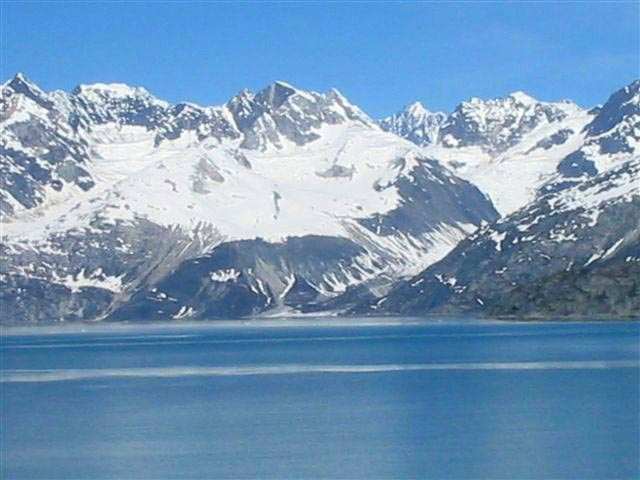 Sunrise, 3:59 a.m.,
Sunset, 10:01 p.m. Glacier Bay became a national monument on February 25, 1925 and was established as a national park and preserve on December 2, 1980. Over 200 species of fish swim in Glacier National Park waters, including all five species of Pacific salmon. Dungeness, king and Tanner crab as well as clams, scallops and shrimp have been harvested by the region's human occupants for centuries. Mosses, lichens, dryas, horsetail and fire weed are among the first plants to appear near the terminus of the retreating glaciers. About 220 bird species or over 25% of the total number of species in all of North America have been recorded in the Park. Moulting or migrating geese and sea ducks find refuge in quiet arms of the bay, and bald eagles nest along much of its shoreline. There are mountain goats, brown bear, coyote, moose, wolf, black bears and more.
Sunrise, 3:59 a.m.,
Sunset, 10:01 p.m. Glacier Bay became a national monument on February 25, 1925 and was established as a national park and preserve on December 2, 1980. Over 200 species of fish swim in Glacier National Park waters, including all five species of Pacific salmon. Dungeness, king and Tanner crab as well as clams, scallops and shrimp have been harvested by the region's human occupants for centuries. Mosses, lichens, dryas, horsetail and fire weed are among the first plants to appear near the terminus of the retreating glaciers. About 220 bird species or over 25% of the total number of species in all of North America have been recorded in the Park. Moulting or migrating geese and sea ducks find refuge in quiet arms of the bay, and bald eagles nest along much of its shoreline. There are mountain goats, brown bear, coyote, moose, wolf, black bears and more.
For more information click here
Glacier Bay National Park Our ship stopped in Glacier Bay for 30-45 minutes, a time that is limited by the EPA to maintain the environment and also to allow other ships into the Bay, since only one ship is allowed in at a time. We saw glaciers calving and heard them thundering into the water. Notice the "glacier blue" especially in the photo on the left. Glacier Bay National Park is one of four parks (the others being Wrangell-St. Elias and Kluane National Parks, and Alsek-Tatshenshini Park in Canada) that create the largest internationally protected area in the world.
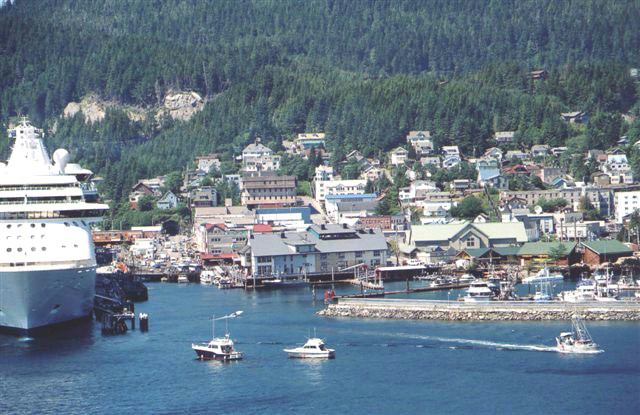 Misty Fjords National Park is 22 air miles east of Ketchikan and is referred to as the Grand Canyon of Alaska, with sheer granite cliffs, plunging 1,000 foot waterfalls, crystalline lakes and low hanging mists. The rustic board walk on Creek Street preserves a distinct historic feel, and the town hums with new construction. Ketchikan is built along a hillside, with sections of the town built over the water on pilings. It is located on the western coast of Revillagigedo Island, near the southernmost boundary of Alaska. Some of us walked the Creek Street board walk past Dolly's House, a former brothel now turned into a museum. It was in a souvenir shop on Creek Street where I found great new shirts for my women's bowling team, the Puffins. The shirts are purple (of course!) with puffins wearing red hats and red boas, perfect...since we four on the team are also Red Hatters.
Misty Fjords National Park is 22 air miles east of Ketchikan and is referred to as the Grand Canyon of Alaska, with sheer granite cliffs, plunging 1,000 foot waterfalls, crystalline lakes and low hanging mists. The rustic board walk on Creek Street preserves a distinct historic feel, and the town hums with new construction. Ketchikan is built along a hillside, with sections of the town built over the water on pilings. It is located on the western coast of Revillagigedo Island, near the southernmost boundary of Alaska. Some of us walked the Creek Street board walk past Dolly's House, a former brothel now turned into a museum. It was in a souvenir shop on Creek Street where I found great new shirts for my women's bowling team, the Puffins. The shirts are purple (of course!) with puffins wearing red hats and red boas, perfect...since we four on the team are also Red Hatters. It lies on the southeastern tip of Vancouver Island and is a picturesque city with many cultures. Most of our group, though on different tours, took a city tour to see the highlights and get an historical overview. From here we could see the Olympic Mountains of Washington State. We saw Victorian style homes, China Town, the Empress Hotel. Victoria also boasts double decker buses like those in England. Though time was limited due to our ship's late arrival, we also had time to walk through Butchart Gardens, an area of 50 acres offering a Japanese Garden, Sunken Garden, Rose Garden among others, and fountains which light up at dusk for a spectacular light show.
Click here to return to Jane & Dale's Home on the Web